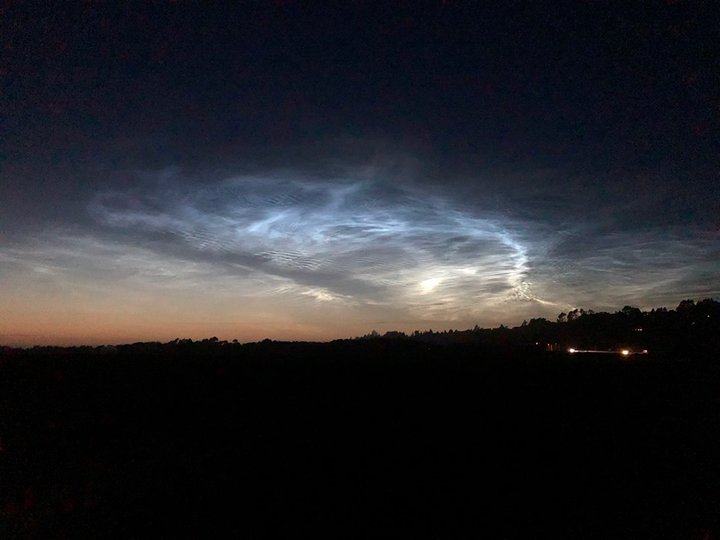
Photo of Sunday’s clouds over Arcata. | Brad Charboneau
###
Local National Weather Service meteorologist Brad Charboneau was driving up Highway 101 Sunday night when he did something he’s done many times before. He looked up.
But what he saw was anything but usual: A night sky glazed with wisps of vibrant, blue clouds hanging in the darkness. It was enough of an oddity for him to pull off the highway and snap a picture that would later be published in the Washington Post.
“At first glance I thought they were ordinary cirrus clouds,” Charboneau said. “But for them to be that bright at that time of night, things weren’t quite lining up. That’s when I realized they were noctilucent clouds.”
Noctilucent clouds, Charboneau says, occur at much higher altitudes than other types of clouds, allowing them to catch the sun’s rays up to two hours before sunrise or after sunset.
“They’re ice crystals way up in the atmosphere, 250,000 feet up, generally speaking.” Charboneau said. “In comparison, cirrus clouds generally form [at elevations] up to 50,000 feet. [Noctilucent clouds] are 50 miles up, so they’re really, really high up there.”
Most noctilucent clouds are believed to be caused by ice forming around meteor dust, the Washington Post reports. However, these sightings are reportedly becoming more common, which scientists say could be linked to climate change.
“It’s not just carbon dioxide that humans pump into the atmosphere. It’s methane, too,” NASA Investigator James Russell is quoted as saying by the Post. “When methane makes its way into the upper atmosphere, it is oxidized by a complex series of reactions to form water vapor. In other words, more methane means more moisture high up.”
Climate change issue or not, Charboneau said the clouds are a rare phenomenon not typically see in Humboldt County.
“It’s really unusual for a latitude as low as we are,” he said. “If they are, they’re more likely to be dim and on the horizon. It was a pretty amazing display.”
Sunday’s cloud event wasn’t unique to Humboldt, however. The clouds were seen by stargazers across the Western U.S., and as far south as New Mexico.
NWS meteorologists in Reno, Nevada and Medford, Oregon also shared images of the rare event on social media. See more images of the clouds below.
Noctilucent clouds over SW Oregon (June 9, 2019) - These rare clouds were visible about 30-60 minutes after sunset Sunday evening. If you missed them, check again just after sunset tonight. Additional information here -https://t.co/0j7e9gQMEV Photos: Marc Spilde pic.twitter.com/y8i7cZ1AbI
— NWS Medford (@NWSMedford) June 10, 2019
They can also be seen in the top right corner of this timelapse from the AlertTahoe network of cameras pic.twitter.com/A6zM2M0hpa
— NWS Reno (@NWSReno) June 10, 2019
CLICK TO MANAGE